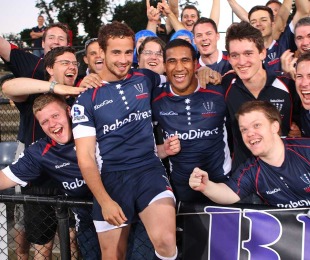|
Comment
Making rugby 'super' again
Keiran Smith
January 31, 2011

The Rebels' Danny Cipriani and Cooper Vuna may help put bums on seats in Melbourne
© Getty Images
Enlarge
Super Rugby was once the world's leading provincial competition. But somewhere along the line it lost its spark. No one knew when it happened, but everyone knew it had happened. Rugby just simply wasn't 'super' anymore. Something had to be done, after all Super Rugby is the stage for the finest, electric running rugby to be played anywhere on the globe. Enter SANZAR. So often fractious and overly political for its own good, the partnership of the three national unions needed to unite and act. Thankfully, they did and not since Super 12 burst on the scene in 1996 has rugby in the southern hemisphere undergone such a transformation. But how did a rugby competition that boasts arguably the best players on the planet fall into disrepair? From an Australian fan perspective, one of the great weaknesses of the previous two Super Rugby formats was the lack of relevance of many of the matches. Teams had generic names that gave no indication as to where they were from and games against local rivals were too few and far between. The introduction of the Western Force and Cheetahs in 2006 gave Super Rugby a short term boost in interest but the key issues remained. Teams would go on road trips for weeks at a time, playing teams, such as the "Sharks", "Stormers", "Bulls", "Chiefs" and "Blues", which gave no obvious indication as to their origin. It's hard in any sport to build a strong brand following when fans don't and can't see their team play live for weeks at a time and when they do, their team is often playing an opponent they often don't know is from either New Zealand or South Africa. To address this SANZAR has taken the format of the competition to something much more akin to American sports where conferences replace an overall league table. The 15 teams, including the new Melbourne Rebels, will be divided into three nationally-based conferences of five teams, one each in South Africa, New Zealand and Australia. Teams will now play 16 matches rather than 13, with each franchise hosting eight home games a season (compared to six or seven in Super 14). But rather than the increased gate takings, the real benefit to the franchises will be the perceived quality of the fixtures to their fan base. With all due respect to the Lions and Cheetahs, they are not drawcards for Australian fans, whereas matches against local rivals are the subject of water cooler conversations every Friday afternoon. With the new conference format half of all season matches will be local derbies and Aussie fans can look forward to 20 regular season derbies opposed to the paltry six we got under Super 14.
Each team will also play four of the other five teams in each of the other two Conferences on a home or away basis (another eight games) with progress being tracked on that team's national conference table. Trust me, it's not as complicated as it sounds. From a SANZAR perspective they will enjoy the benefit of a greatly reduced travel bill as each team will now play 12 of its 16 regular-season games within its own country and not have to send squads of 30 players plus officials on lengthy international road trips. One of the key features of the new tournament is the expanded finals series. In Super 14 only four teams were involved in just a two week finals series, an anti-climax so often a bugbear for fans and the franchises alike. SANZAR has taken heed as the new finals format will see the conference winners joined by the next best three teams (based on points) from any conference in a three week finals series. Conference winners are ensured of a home final, meaning at least one finals match will be played in prime time in each country each year. So does a tournament with more home matches, more local derbies, more finals and increased relevance to a discerning Australian sporting market sound too good to be true? The proof, as they say, will be in the pudding or more accurately the bums on seats and the all-important TV ratings. Only time will tell as Super Rugby's enters a brave new world. © ESPN Sports Media Ltd.
| |||||||||||||||
Live Sports
Communication error please reload the page.
-
Football
-
Cricket
-
Rugby
-
- Days
- Hrs
- Mins
- Secs
F1 - Abu Dhabi GP
Abu Dhabi Grand Prix December 11-131. Max Verstappen ()
2. Valtteri Bottas (Mercedes)
3. Lewis Hamilton (Mercedes)
4. Alexander Albon ()
5. Lando Norris ()
6. Carlos Sainz Jr ()
-
ESPNOtherLive >>
Snooker - China Open
Tennis - Miami Open

